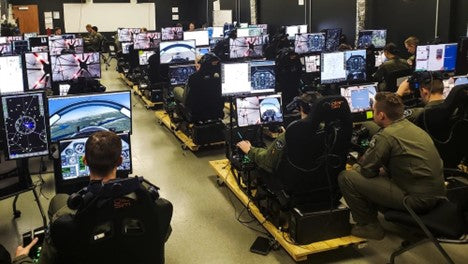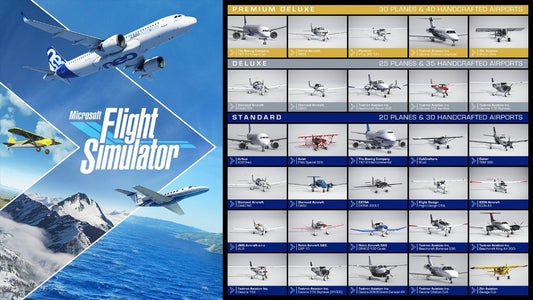The Role of Simulators in Military Training – Complete Guide

The integration of simulation technology into the military world is one of the most revolutionary developments in operational effectiveness and tactical readiness. The very prospect of harnessing advanced simulation systems in the military not only fosters new training opportunities for the armed forces but also enhances their decision-making prowess in all types of critical situations.
Simulators have long since played a crucial role in the military sector, particularly in military planning and battlefield strategic thinking. However, as military operations are becoming increasingly dynamic, there is an increased requirement for more intricate capabilities from armed forces. This includes everything from combat training to tactical and strategic applications on the field. And this is where the role of simulators in military training in today’s complex applications comes into play.
Simulator Benefits in Military Training

But before we dive into the role of simulators in military training, let us first look into why their role is so important.
It’s not like that; without simulators, military personnel won’t be able to train. Even without simulators, everything can be replicated to create an ideal training environment where armed forces can conduct training activities. The downside? It will cost a fortune, especially when training programs require a significant number of trial runs before one can complete them!
Simulators save us from spending recklessly on these things in military training. This makes it a very lucrative option for cost-effective training. Not only can armed forces train over and over again, but they can also avoid any form of injury that may occur during training.
And this brings us to our second point on why the role of simulators in military training is so important: safety. Military training programs are no joke. They can be quite intensive sometimes, which can drain you both physically and mentally.
This increases the probability of you getting into accidents. But with simulators… no such thing like that exists. You can make mistakes, learn from them, and try again—all in a completely risk-free environment. This kind of hands-on experience is hard to get anywhere else.

Another crucial point as to why the role of simulators in military training is so adored is that they let personnel train anytime. This is in stark contrast to a real open ground training environment, where weather conditions and time of day determine whether the training program can be accurately executed or not.
Continuing with the flow, when one is training, it’s hard to keep track of the progress that one is making. Sure, hiring a supervisor will make things easy, but humans are prone to error, right? This is yet another area where the role of simulators in military training outshines. In addition to keeping a track record of your performance in training programs, simulators can also provide critical insights into areas that need more improvement than others.
All this results in an enhanced skill development of military personnel as well as improved decision-making abilities alongside team cohesion and communication enhancement.
Now that you know how crucial the role of simulators is in military training, let us now see the real-world applications in the military sector where simulators play a key role in the training of military personnel.
The Role of Simulators in Military Training
As seen above, the role of simulators in military training isn’t just about virtual environments or flashy digital screens—it’s about transforming how armed forces train, react, and execute in real-world scenarios. They are at the very core of today’s military training ecosystems—whether it’s air, land, sea, or even the medical units operating behind the lines. Their ability to replicate real-world scenarios without the costs, dangers, or logistical complications of live training makes them invaluable.
Aircraft Simulators

For instance, when it comes to developing pilots, aircraft simulators have revolutionized pilot training. These are not your average "flight simulator" games you could find at the neighborhood Game Stop—but are instead incredibly complex, detailed renderings of actual cockpit scenarios created through high-fidelity visuals, motion sensing-based systems, and physics-based surroundings that replicate real flight challenges.
From military aviation simulations, military pilots learn everything from proper takeoff to engaging in extensive dogfights in the sky. Why? Because they are trained to experience anything that can happen in the sky—failing engines, extreme turbulence, and enemy artillery—with none of the risks or costs associated with being in the sky in a live aircraft.
The role of simulators in military training here becomes crystal clear. Not only do they drastically cut down the costs of fuel, aircraft maintenance, and airspace coordination, but they also allow pilots to train intensively and repeatedly. Mistakes made in a flight simulator are no longer deadly mistakes, and instructors have access to real-time analytics of performance while in simulation to assess strengths and weaknesses that need to be adjusted.
And in the current age of drone warfare and multi-role fighters, simulators are now integrating VR (Virtual Reality) and AI-driven combat environments to keep training aligned with evolving aerial warfare dynamics.
Infantry Simulation Systems

The battlefield is chaotic. Loud, unpredictable, fast-moving. Which is why ground troops need a particular tactical system to ultimately achieve similar objectives. These are the Infantry simulation systems that put personnel in a battle situation without live rounds and without loss of life.
Typical characteristics include:
- VR-based headsets with full 360° battle space
- Weapons systems with recoil, reloading and aiming features integrated
- Team overlays for communication, field talk and radio communications
From room clearing during urban combat to field exercises with large groups, these sessions harness reflex, situational awareness, and collaboration. Soldiers learn how to clear a room, read a field, and where to conceal themselves or their comrades from fake gunfire to facilitate split-second decision making.
The role of simulators in military training, especially for infantry, is pivotal here: it offers a highly repeatable, data-driven, and adaptive training loop that no traditional boot camp or field drill can match in efficiency.
Naval Simulations

Maritime operations are a whole different ballgame—highly technical, deeply strategic, and often dependent on coordination across massive fleets and systems. Naval simulation platforms are designed to bring that entire ecosystem into a single, responsive training environment.
These simulators recreate everything from:
- Ship navigation and control room operations
- Tactical naval combat (torpedoes, sonar, radar evasion, etc.)
- Crew communication, crisis management, and joint operations with air or land forces
In these simulations, sailors and officers learn how to respond to real-time threats like submarine attacks, piracy, electronic warfare, or severe weather—all without the logistical nightmare of organizing full-scale naval exercises.
Once again, the role of simulators in military training here isn't just about “learning to sail”—it’s about strategic preparedness, inter-unit coordination, and fast decision-making under pressure.
Medical Simulations

There's no doubt that medics are a staple in military operations, working in war zones where their critical, life-and-death decisions made in the blink of an eye can either solidify or sabotage a mission. However, training military medics in real-life scenarios is fraught with ethical and situational concerns. Medical simulators resolve the issue in shockingly realistic fashions.
From high-fidelity mannequins who breathe as humans do to virtual operating rooms depicting various war-influenced injuries, these training systems allow medics to experience the worst of times. They can practice trauma techniques, on-site triage, and injuries that require immediacy to the operating room without the chance of an accidental death occurring with a live patient.
In addition, medical simulators possess the ability to recreate any scenario. Instructors can turn up or down the sensitivity, include unexpected problems, or create a high-stress environment to evaluate medical skill and stability. Thus, the role of simulators in military training here ensures that military medical personnel are just as comprehensively prepared, if not more, for any situation they may face.
Tactical Training Simulations

Perhaps the most adaptable application of simulation occurs as tactical training—multi-layered systems of soldiers, leaders, allied forces, or enemy combatants that set people against one another, sometimes with AI assistance.
For example, within command posts, military commanders undertake live simulations of their missions, from insertion to extraction. By utilizing the extensive data feeds available to them, digital mapping and interactive elements, command staff can theoretically see the outcomes of strategies, edit mission briefs, and amend logistical requirements in real-time.
From sending a UAV to provide overwatch to an infantry squad executing a counterinsurgency mission in an urban setting to a joint strike that necessitates air support and ground troop engagement to simultaneously strike enemy combatants, these types of simulations teach adaptability as they convert a theoretical plan into a real-time exercise that aligns leadership with an understanding of real-time decision-making and how those decisions affect the chain of command.
And again, we see how the role of simulators in military training becomes invaluable. By reducing uncertainty and increasing strategic foresight, it prepares military leaders for real-world command decisions where there are no do-overs.





